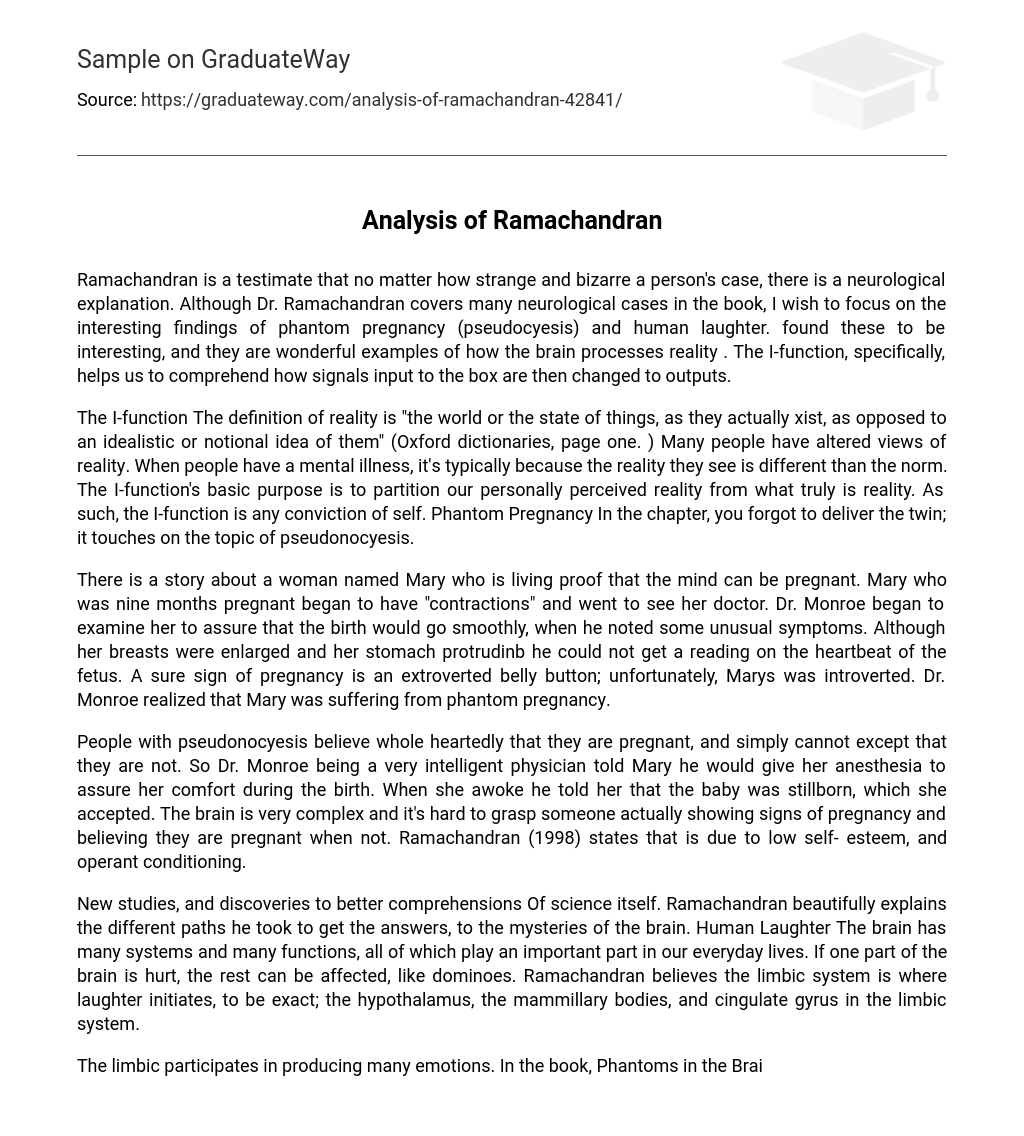Ramachandran is a testimate that no matter how strange and bizarre a person’s case, there is a neurological explanation. Although Dr. Ramachandran covers many neurological cases in the book, I wish to focus on the interesting findings of phantom pregnancy (pseudocyesis) and human laughter. found these to be interesting, and they are wonderful examples of how the brain processes reality . The I-function, specifically, helps us to comprehend how signals input to the box are then changed to outputs.
The I-function The definition of reality is “the world or the state of things, as they actually xist, as opposed to an idealistic or notional idea of them” (Oxford dictionaries, page one. ) Many people have altered views of reality. When people have a mental illness, it’s typically because the reality they see is different than the norm. The I-function’s basic purpose is to partition our personally perceived reality from what truly is reality. As such, the I-function is any conviction of self. Phantom Pregnancy In the chapter, you forgot to deliver the twin; it touches on the topic of pseudonocyesis.
There is a story about a woman named Mary who is living proof that the mind can be pregnant. Mary who was nine months pregnant began to have “contractions” and went to see her doctor. Dr. Monroe began to examine her to assure that the birth would go smoothly, when he noted some unusual symptoms. Although her breasts were enlarged and her stomach protrudinb he could not get a reading on the heartbeat of the fetus. A sure sign of pregnancy is an extroverted belly button; unfortunately, Marys was introverted. Dr. Monroe realized that Mary was suffering from phantom pregnancy.
People with pseudonocyesis believe whole heartedly that they are pregnant, and simply cannot except that they are not. So Dr. Monroe being a very intelligent physician told Mary he would give her anesthesia to assure her comfort during the birth. When she awoke he told her that the baby was stillborn, which she accepted. The brain is very complex and it’s hard to grasp someone actually showing signs of pregnancy and believing they are pregnant when not. Ramachandran (1998) states that is due to low self- esteem, and operant conditioning.
New studies, and discoveries to better comprehensions Of science itself. Ramachandran beautifully explains the different paths he took to get the answers, to the mysteries of the brain. Human Laughter The brain has many systems and many functions, all of which play an important part in our everyday lives. If one part of the brain is hurt, the rest can be affected, like dominoes. Ramachandran believes the limbic system is where laughter initiates, to be exact; the hypothalamus, the mammillary bodies, and cingulate gyrus in the limbic system.
The limbic participates in producing many emotions. In the book, Phantoms in the Brain, the chapter titled “The Woman Who Died of Laughter”, Ramachandran gives a story about a man named Willy. Willys mother died of unknown causes, and the chapter opens with Willy ttending his mother’s funeral. In a situation like this, people generally morn, miss their parent and shed tears. But no, not Willy, he begins to laugh, and once started he cannot stop, so he laughs hysterically. His family is appalled and confused, so they take him to the doctor.
The doctor finds nothing wrong but Willy continues to laugh so they keep him on as an patient. Two days later a staff member found Willy unconscious from a subarachnoid hemorrhage. Willy died before he ever knew he’d stopped laughing. Willy had a brain aneurysm that had crushed his hypothalamus, mammillary, other odies, and structures of the brain. The I-function participates in these situations by sending signals back and forth the frontal lobe, and again provides a screen in between reality that the laughter is inappropriate and the I-function is saying laugh.
Ramachandran formed a hypothesis of why laughter originated. I find his theory extremely fascinating . He believes we laugh to give a false alarm. An analogy he made is seeing what you think is a snake in the grass and then realizing it is simply a stick, you will most likely laugh to let yourself and others around you know it was a false alarm. To be concise his theory implies that laughter is you saying “IT’S O. K. ” Have you ever noticed when we laugh its usually very loud and obnoxious?
This fact actually fits in with Ramachandran’s theory, if we do laugh to signal people then that would explain our need to laugh in such an explosive nature. “A signal is much more valuable if it amplifies and spreads like wildfire in the group” says ( Ra machandran,1998, page) There are flaws within this theory; for example if you are signaling ‘false alerts” by your laughter, why would you laugh when you hear a pun or joke? Or if almost walk out in front of a bus, but once realized I am safe, I do not burst into a fit of uncontrollable laughter.
Although Willys story does give some legitimacy to why we believe laughter comes from the limbic system, it does not prove laughter evolved as a false alarm. Conclusion In his book, Ramachandran covers many topics including phantom limbs, phantom pregnancies, our body image, memory, laughter, delusions,and hallucinations. He does not simply drag on discussing why these physiological systems are the way they are; instead, he gives us examples through his atients. I believe this book was very well written.





